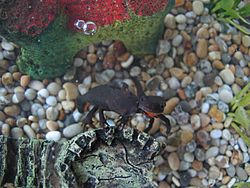Chinese fire belly newt facts for kids
The Chinese fire belly newt (Cynops orientalis) is a small and colorful amphibian. These newts are known for their bright orange bellies, which stand out against their dark backs. They are often found in pet stores and can be a fun pet to learn about. They grow to be about 2.2 to 4 inches (6 to 10 cm) long.
Quick facts for kids Chinese fire belly newt |
|
|---|---|
 |
|
| Conservation status | |
| Scientific classification | |
| Kingdom: | |
| Class: | |
| Order: | |
| Family: | |
| Genus: |
Cynops
|
| Binomial name | |
| Cynops orientalis (David, 1873)
|
|
Contents
Discover the Chinese Fire Belly Newt!
The Chinese fire belly newt is a fascinating creature. Its scientific name is Cynops orientalis. These newts have smooth skin and a round tail. This helps tell them apart from other similar newts.
What Do They Look Like?
These newts are easy to spot because of their bright colors. Their backs are usually black or dark brown. But their bellies are a vibrant orange or red. This bright color is a warning sign to predators. It tells them that the newt might taste bad or be poisonous. This defense is called aposematism.
Where Do They Live?
Chinese fire belly newts are native to China. They live in slow-moving water like ponds and streams. They can also be found in rice paddies. As amphibians, they spend time both in water and on land. They need a moist environment to survive.
Are They Good Pets?
Many people keep Chinese fire belly newts as pets. They are popular because of their small size and interesting colors. It is important to know how to care for them properly. This includes having a good tank with both water and land areas. They also need the right food and clean water.
How Are They Different from Other Newts?
Sometimes, the Chinese fire belly newt is confused with the Japanese fire belly newt. Both are small and have similar colors. However, the Chinese fire belly newt has smoother skin. Its tail is also rounder. The Japanese fire belly newt has rougher skin and a more pointed tail.
Images for kids
See also

- In Spanish: Hypselotriton orientalis para niños






